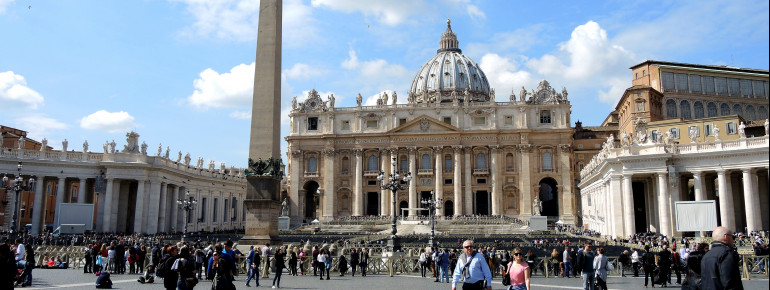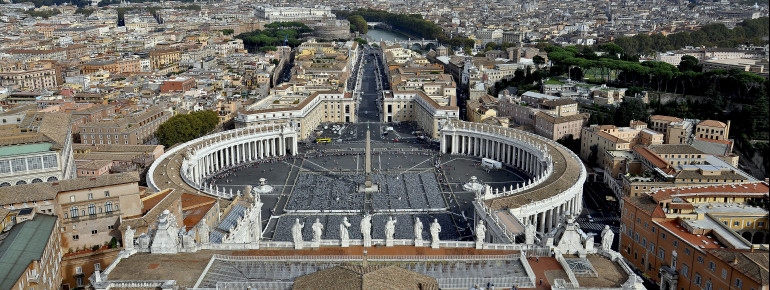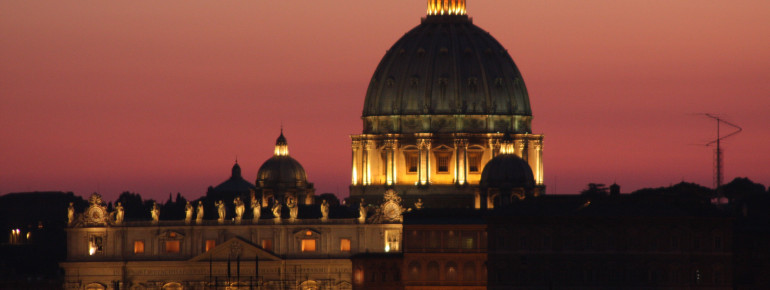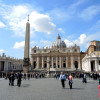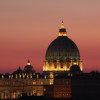Contents
Description
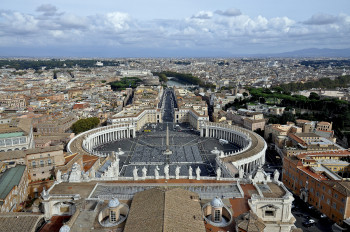
St. Peter's Basilica with its magnificent facade, dating from the 16th century, is one of the largest and most beautiful churches in the world. By order of Emperor Constantine, around the year 320, a huge basilica was built over the presumed tomb of the Apostle Peter, the dimensions of which roughly corresponded to those of today's St. Peter's Basilica.
Over the centuries and under the influence of various popes, the old basilica was completely renovated. Artists such as Bernini, Michelangelo and Bramante were involved in this process. The impressive dome of St. Peter's Basilica, designed by Michelangelo, can be viewed from the inside as well as from the outside after a strenuous climb. With a diameter of 42.34 m, it is the largest cantilevered brick structure in the world.
Not only its function as the central sanctuary and pilgrimage site of the Roman Catholic Church, but also the many works of art by famous masters, such as Michelangelo's Pietà and the Cathedra Petri, a larger-than-life replica of a throne created by Bernini, make St. Peter's Basilica a very special place.
St. Peter's Square
Just in front of the basilica, one finds the St. Peter's Square, which was designed and built by Gian Lorenzo Bernini in the period from 1656 until 1667. Through its form (oval, then towards the basilica trapezium-shaped) the dome is particularly highlighted and the facade is optically narrowed. In the centre of the square, an obelisk is placed. Legend has it that it still stems from the circus saint Peter was killed in. The square, which is a part of the Vatican State, is framed by two semi-circularly arranged colonnades with each carrying four rows of pillars. On the colonnades, you'll find statues modeled on 140 saints.
Sightseeing
The early bird catches the worm! Getting up early before going to St. Peter's Square is worth it as it quickly gets crowded and the queues longer. Make sure you are appropriately dressed, shoulders and knees need to be covered.
One shouldn't miss visiting the dome. You can either walk the entire way on foot or, if this is too challenging, take the lift and just walk the last leg. From here one enjoys a stunning view on the city of Rome.
When here, it's also worth paying a visit to the crypt, where all popes lie buried. The remains of St. Peter are said to be stored here too, which St. Peter's Basilica was built on.
Historical Information
Without a doubt, St. Peter's Basilica is one of the largest and most beautiful churches in the world with its gorgeous facade dating back to the 16th century.
On behalf of emperor Constantine, the construction works began on the site of the alleged death place of apostle Peter in the year 320 AD. In its appearance and size, the original construction equals the modern-day edifice.
Throughout the centuries and under the influence of several Popes the old basilica had been completely renewed. Bernini, Michelangelo and Bramante, to name just a few, were the artists to have influenced the architectural shape of the basilica the most. Michelangelo designed the impressive dome of the St. Peter's Basilica, which one can admire from the inside as well as from the outside. Furthermore, it is one of the largest unsupported brick work constructions in the world, measuring a diameter of 42.34 m (46.3 yd).
Not only its function as a central sanctuary and pilgrimage site of the Roman-Catholic Church, but also the numerous artworks by famous artists, such as the replica of Michelangelo's Pietà and the Cathedra Petri by Bernini, a larger than life throne replica, altogether make the St. Peter's Basilica a very special place.
Interesting facts
- Basilica of St. Peter Rome is among the 10 best rated Tourist Attractions in Italy.
How to get there

By tram
Line 19 will take you here.
By bus
Get on either of the following lines 32, 81, 590, and 982 and get off at “Piazza del Risorgimento”.
By subway
Take line A and leave the subway at the station “Ottaviano/ San Pietro”.

